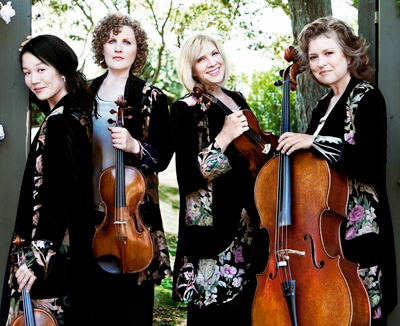by Daniel Hathaway

Pianist Vivian Hornik Weilerstein joined Annie Fullard, Mari Sato, Kirsten Docter and Merry Peckham for Shostakovich’s Piano Quintet in g, op. 57, a piece that visits a wide range of emotions and musical styles. The Cavani stripped their tone of vibrato in the second movement fugue to excellent effect, and in company with Weilerstein, brought out the striking cross rhythms in the third movement Scherzo. Fullard’s solo over pizzicatos at the beginning of the fourth movement Intermezzo was ravishing — as was her unaccompanied solo at the end. Strings and pianist played the sprawly, amiable Allegretto that closes the five-movement work with affecting charm and a delicious blend of tone.
Shostakovich’s Quartet No. 9 in E-flat, op. 117, a five-movement work played without pause, is another matter entirely. The dark, meandering Moderato led to an Adagio spiky with cross-relations and a dance-like Allegretto whose main idea was later repeated with mutes on. The stunner was the Adagio. Somewhere toward the middle, Shostakovich requires the second violinist to suddenly lose her mind, flying off on a tangent of wild, snap pizzicatos. Mari Sato did that with gusto. Soon after, Shostakovich passes that idea on to the cellist, leading Merry Peckham to a similar episode of musical insanity. The almost unbearably intense, rustic dance that ends the piece was fraught with inner meaning. (A colleague told me at intermission that if it had gone on for five more minutes, he might have had a heart attack.) The Cavani held on tight through the whole course of this eventful and challenging piece, winning loud cheers from the large audience.
Something like Mendelssohn was required to restore emotional equilibrium, and his second quintet in B-flat, op. 87 fit the bill nicely. A nice moment of levity preceded the performance when guest violist Donald Weilerstein announced that he had brought the wrong glasses to the stage. While he went to fetch the right pair, Annie Fullard confessed that she didn’t have any viola jokes to tell, but filled in with a groaner the quartet probably uses in their school performances. “Why couldn’t they find Mozart?” “Because he was Haydn,” Peckham shouted out.
The quintet approached the Mendelssohn with a full measure of hearty cheerfulness, maintaining their focus and cohesion from beginning to end with only one brief lapse in intonation. Violists Weilerstein and Docter matched each other’s sound beautifully, giving the ensemble extra heft and color in the tenor register. Annie Fullard expertly shaped her mini-cadenzas in the slow movement, and the final Allegro was energized by the volleys of sixteenth notes that Mendelssohn passed around the group. A big ovation followed, reflecting not only the quality of the performance but also the high regard in which these four women are held at CIM and in the community.
Published on ClevelandClassical.com March 13, 2015.
Click here for a printable copy of this article



